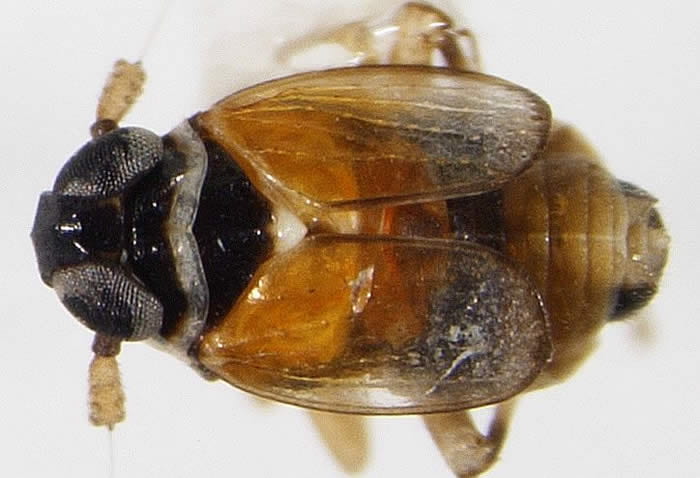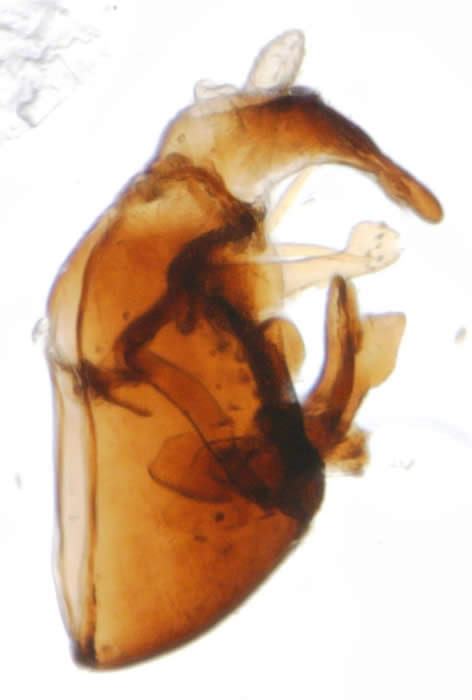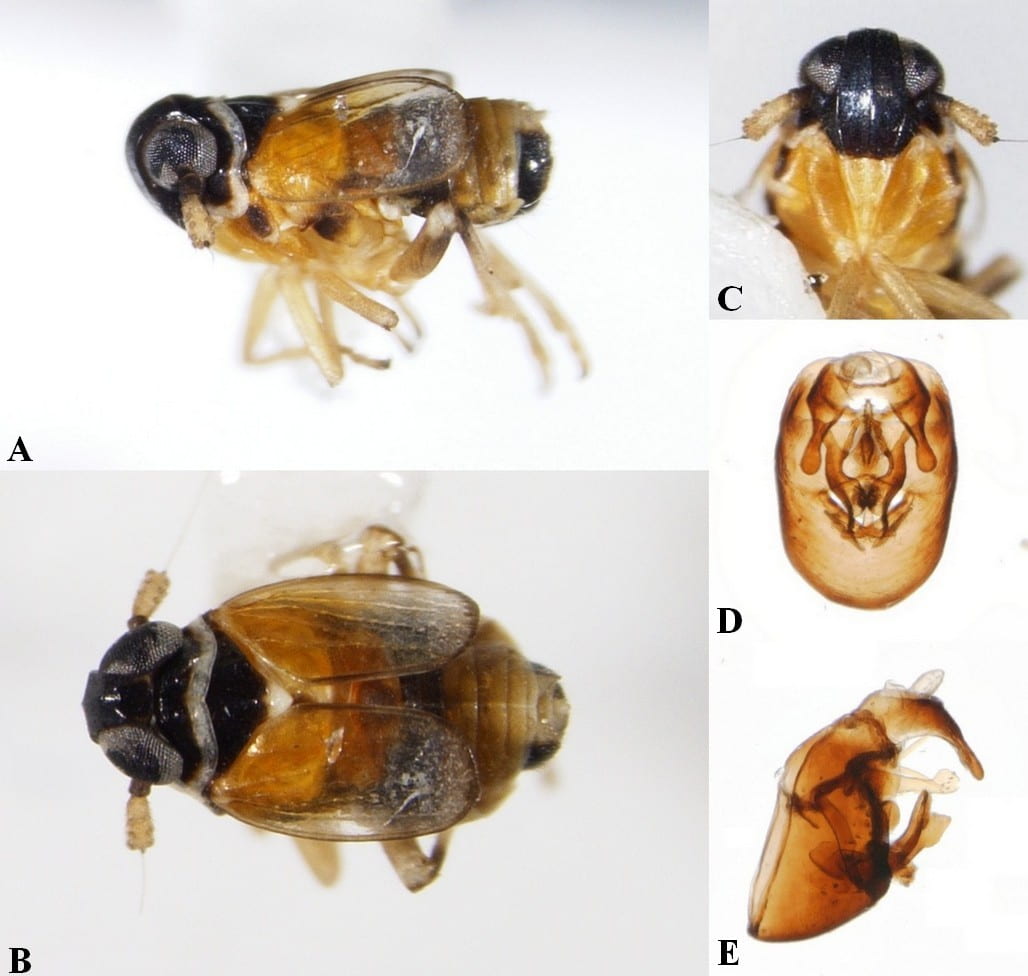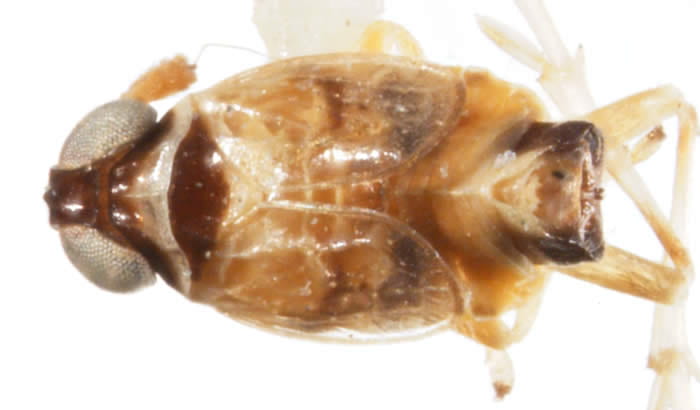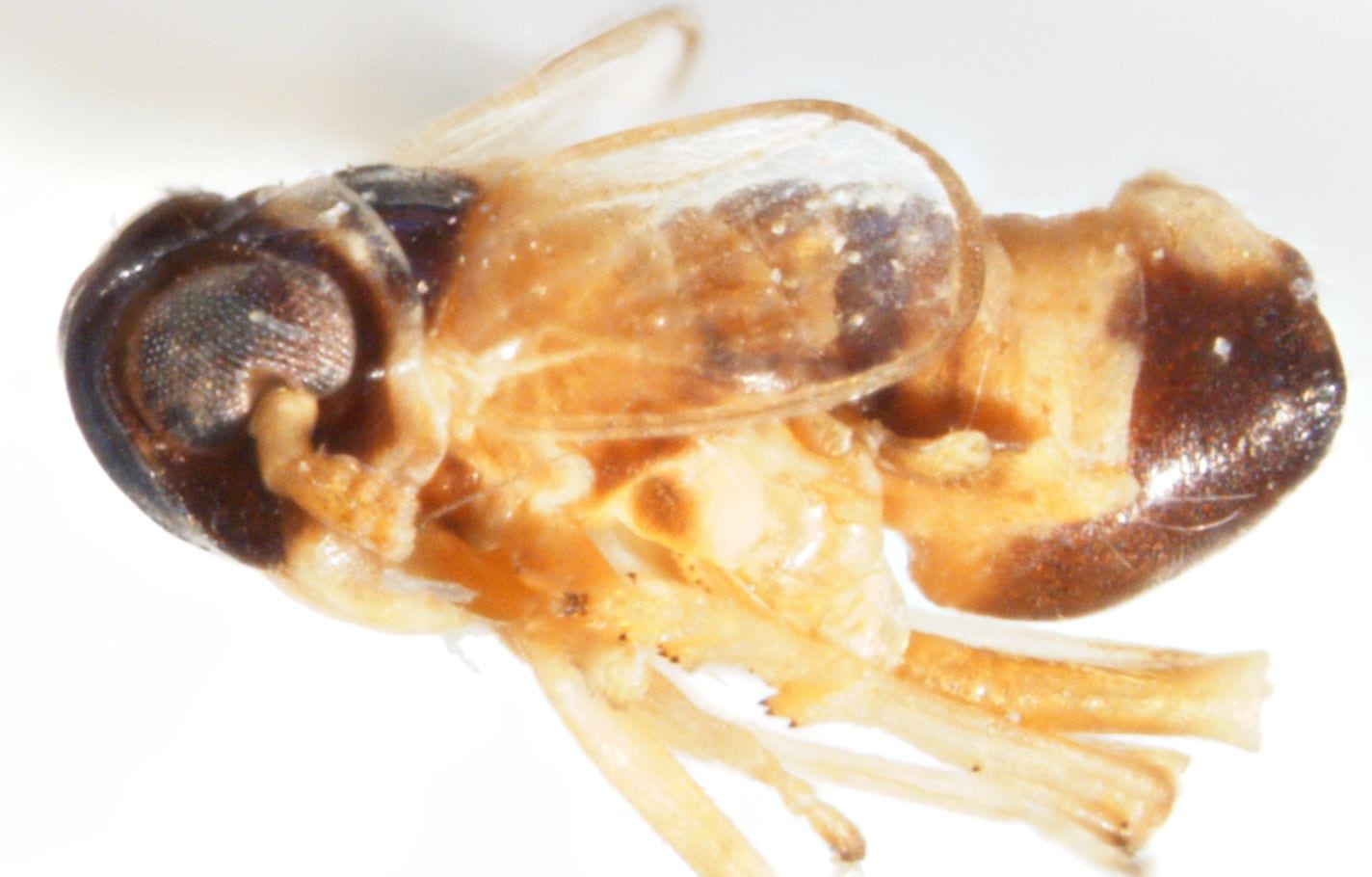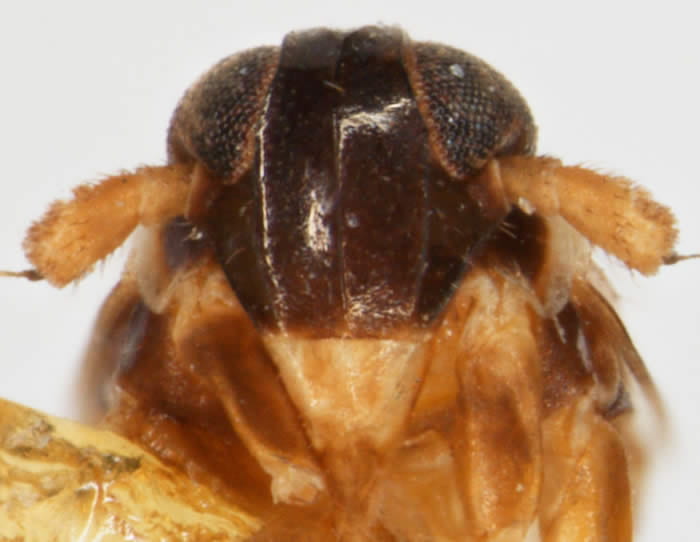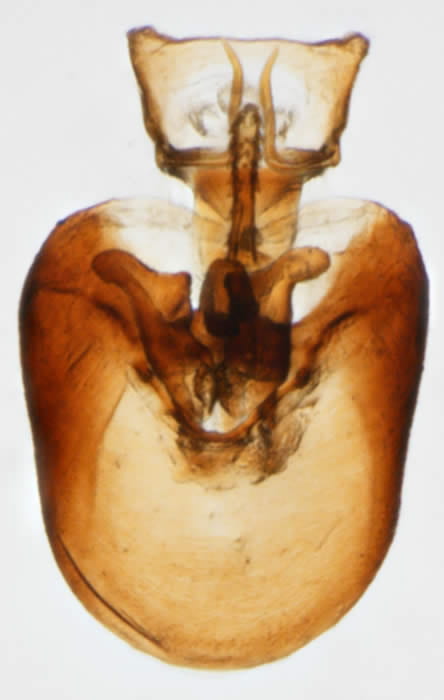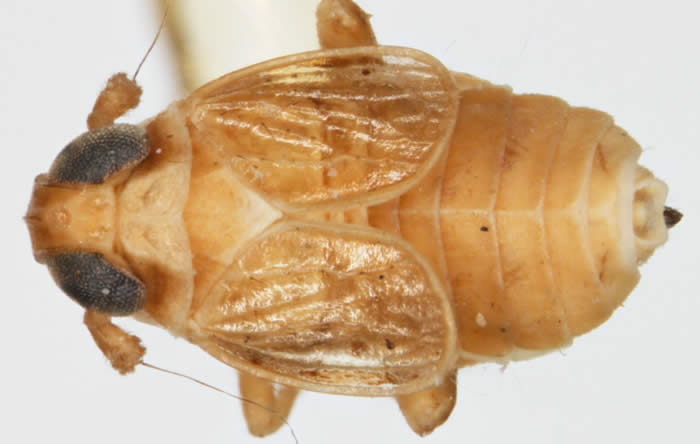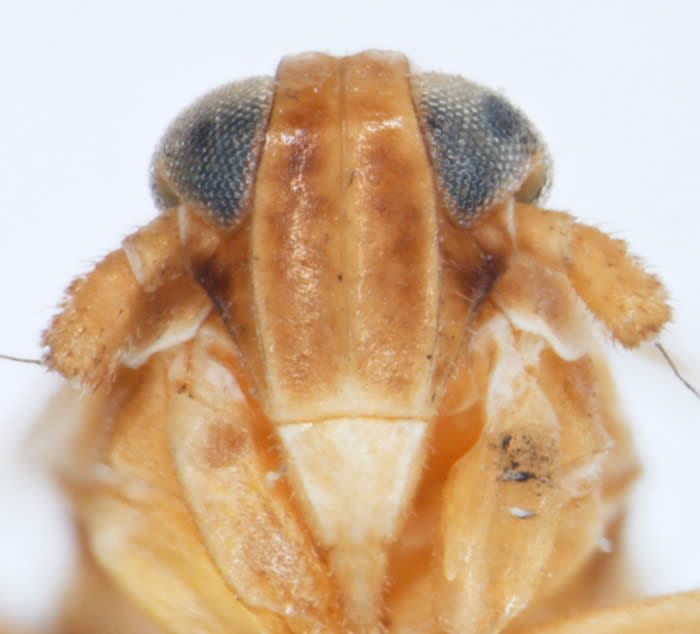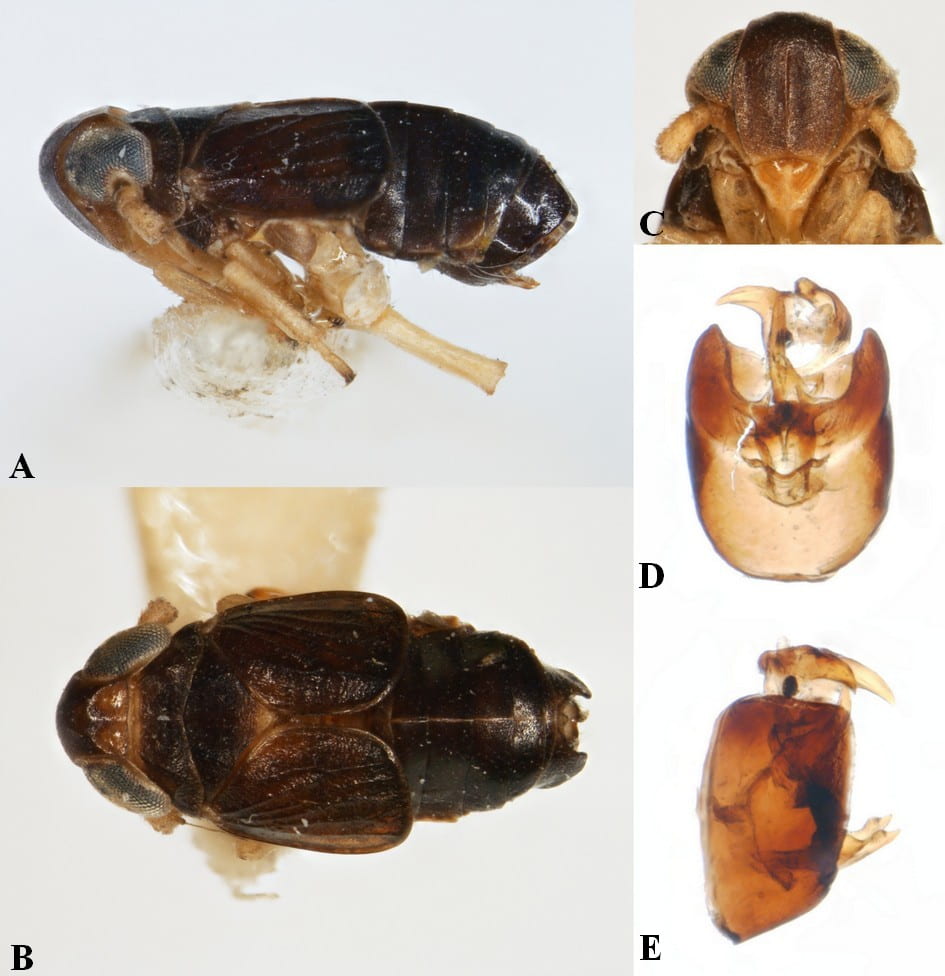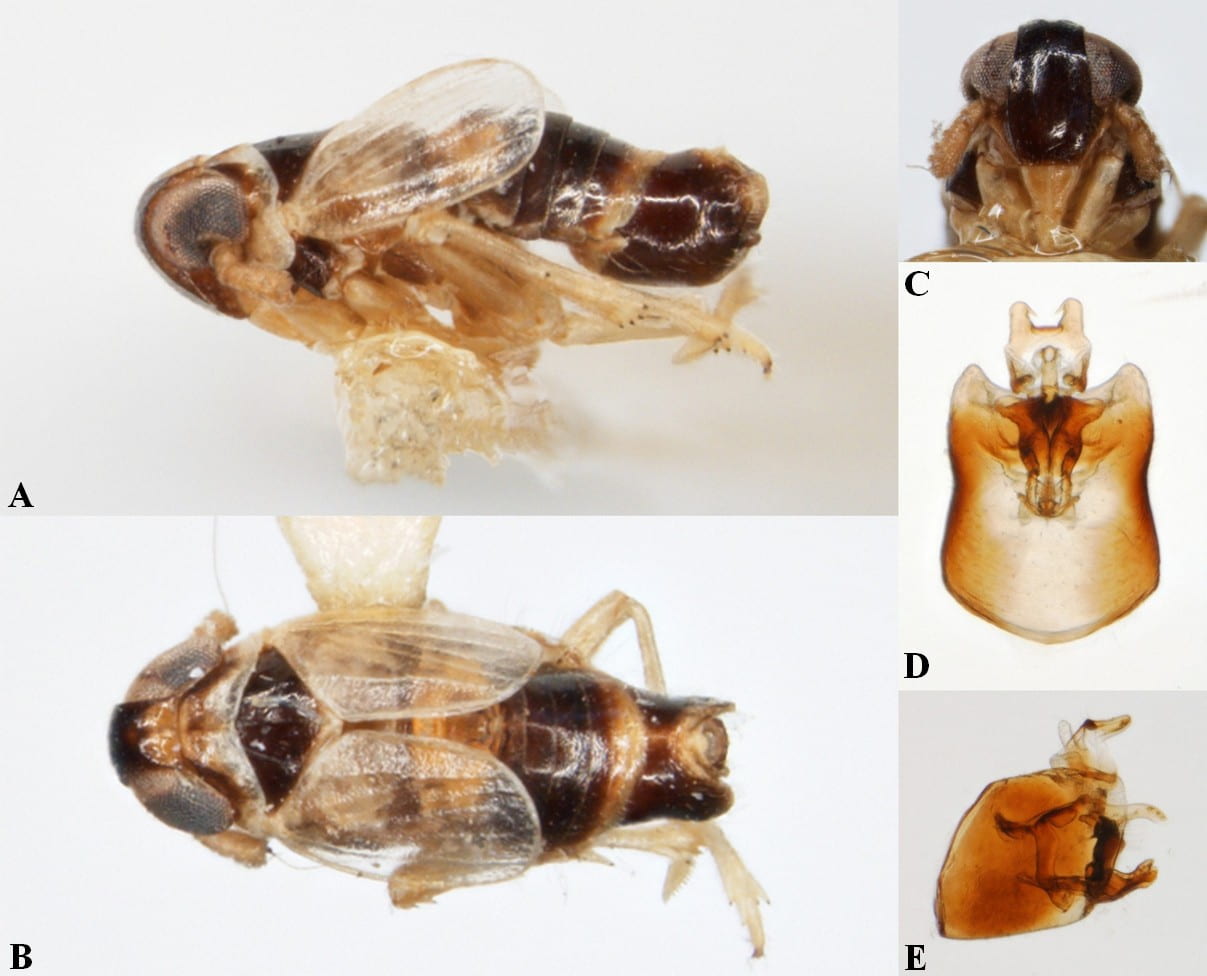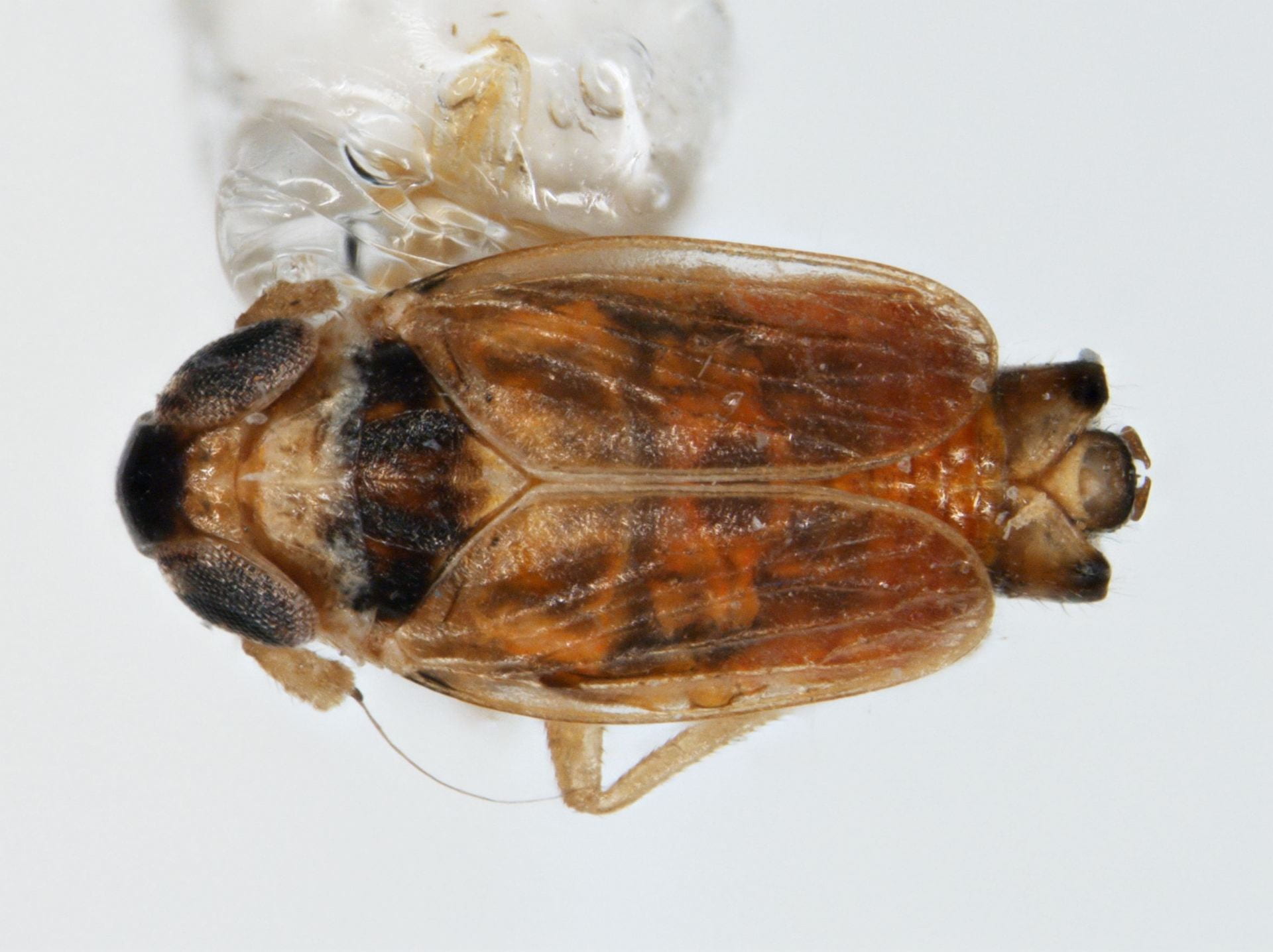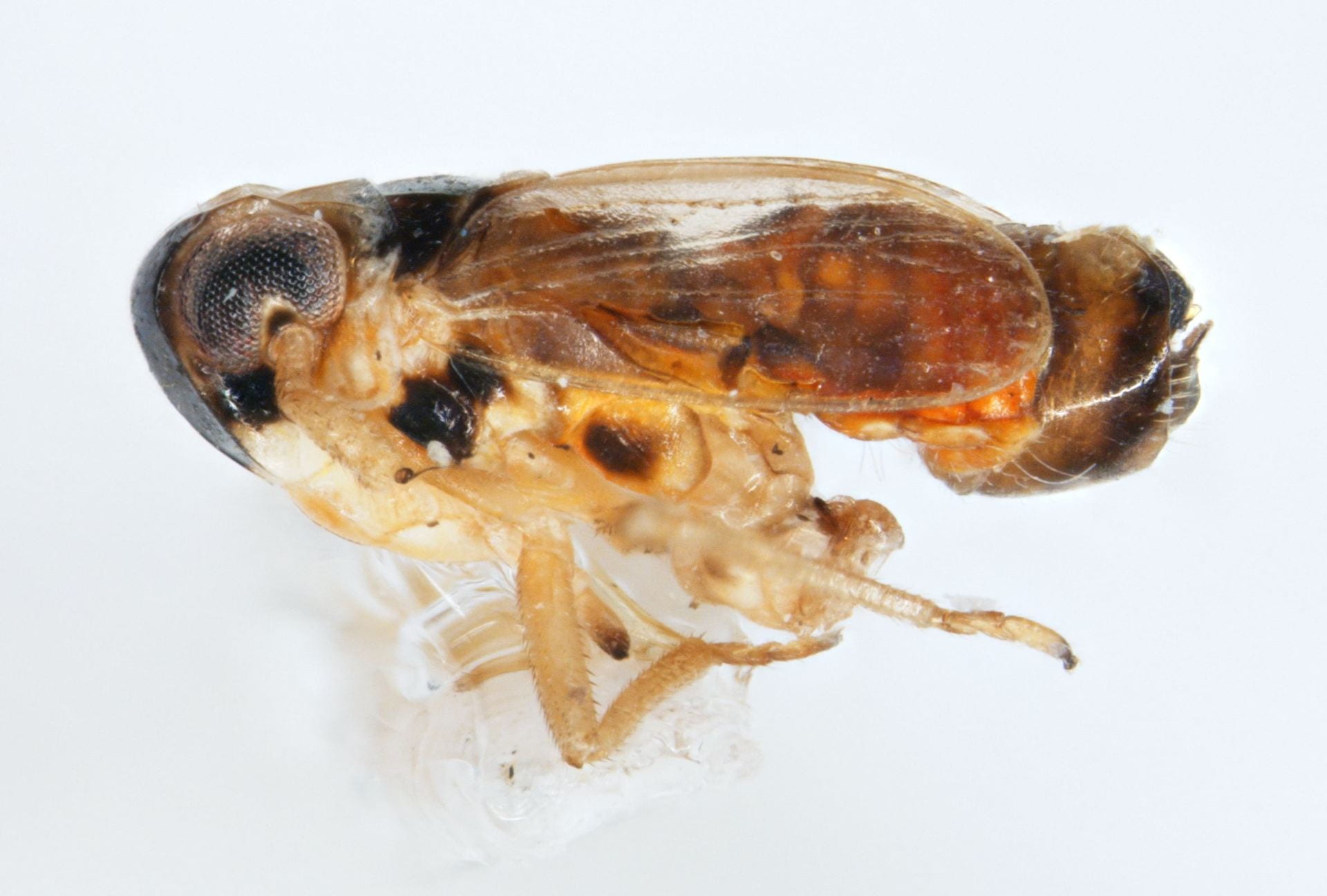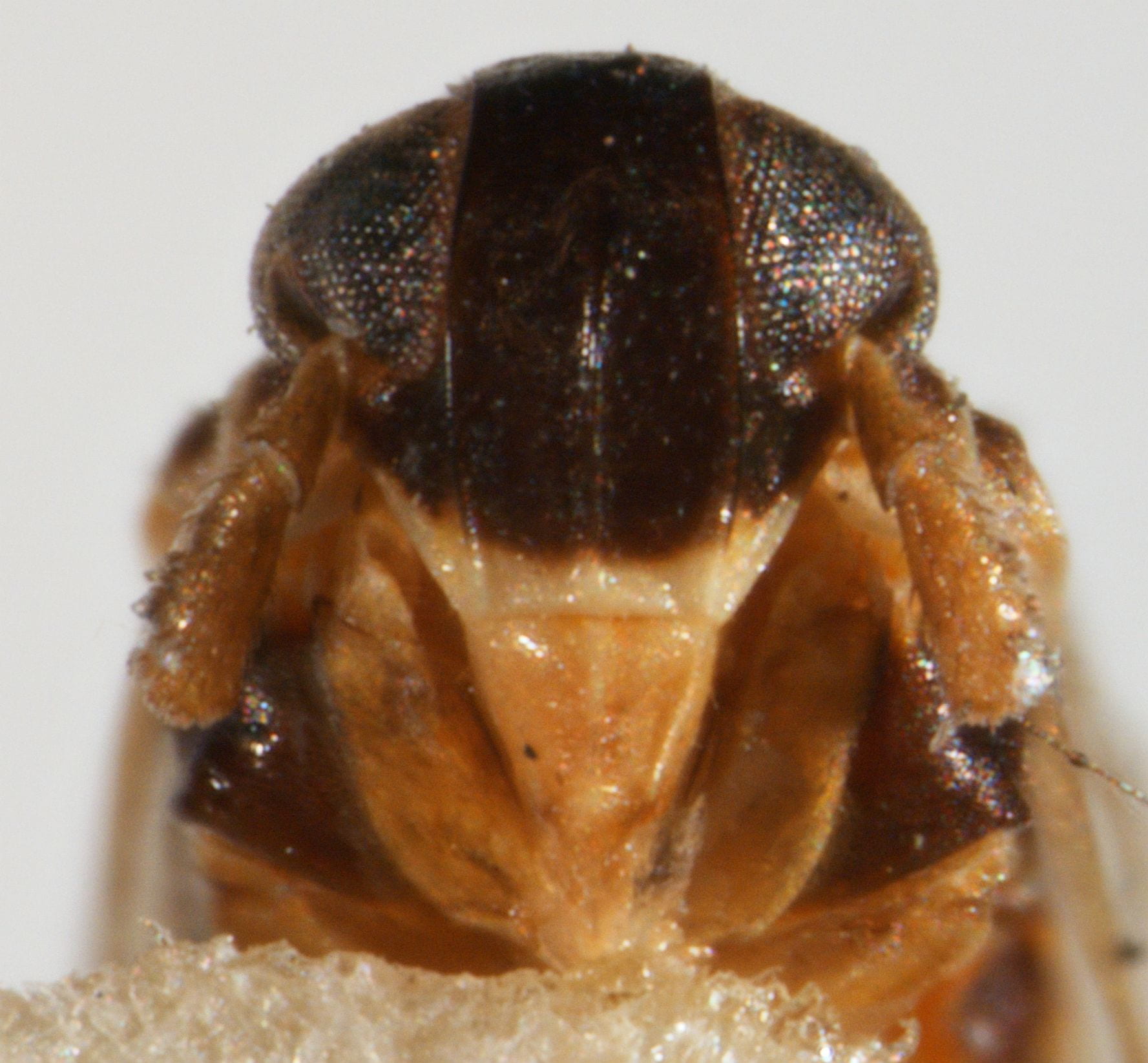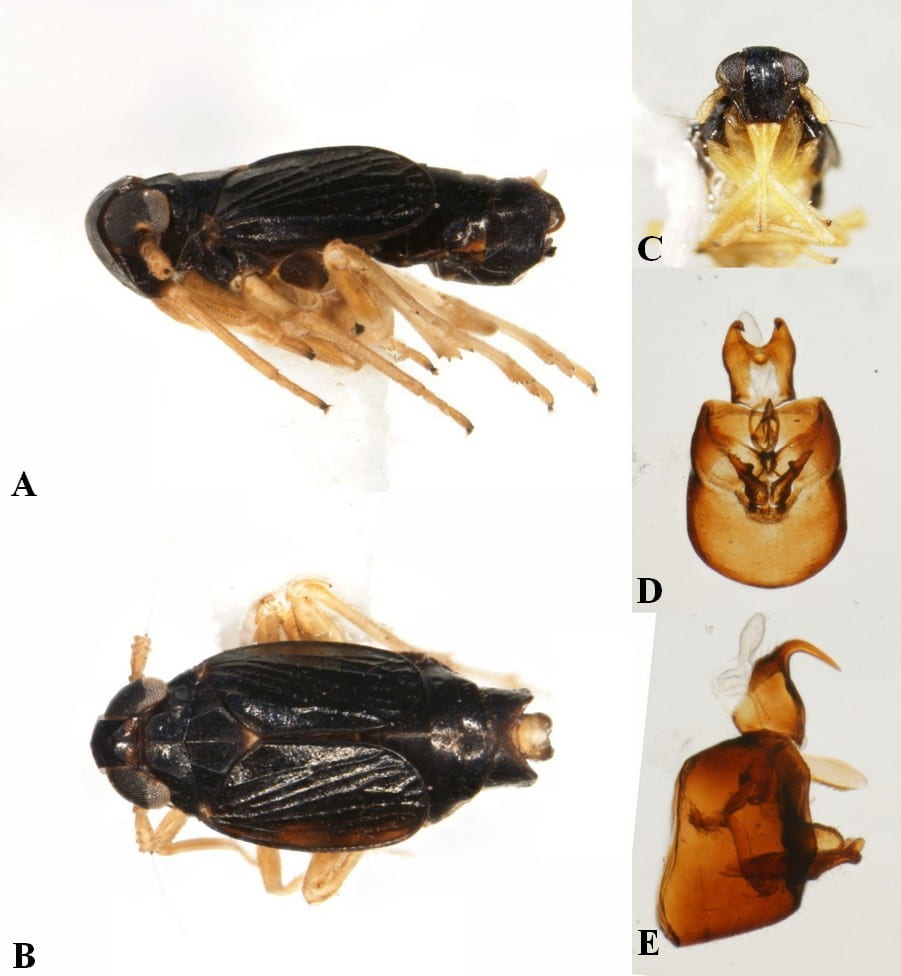[Back to Higher classification of Delphacidae]
Contents
Family Delphacidae Leach, 1815
Subfamily Delphacinae Leach, 1815
Tribe Delphacini Leach, 1815
Genus Flavoclypeus Kennedy and Bartlett, 2014: 23.
Type species: Liburnia andromeda Van Duzee, 1907: 46.
Distribution
Primarily North and Mesoamerica.
Recognized Species
There are 8 species in this genus as follows:
1 Flavoclypeus aduncus (Beamer 1948b) – USA (FL, GA, NC).
= Delphacodes adunca Beamer 1948b: 98.
= Flavoclypeus aduncus (Beamer 1948b); combination by Kennedy and Bartlett 2014: 26.
2 Flavoclypeus andromedus (Van Duzee, 1907) – USA (AL, AR, CT, DC, DE, FL, GA, KS, KY, LA, MA, MD, NC, NJ, OH, OK, PA, SC, TN, TX, VA), Belize, Cuba, Guyana, Jamaica, Puerto Rico (for original locality reports, see (Crawford 1914, Osborn 1926, 1929, 1935; Spooner 1920, Van Duzee 1907).
= Liburnia andromeda Van Duzee, 1907: 46.
= Megamelus andromedus (Van Duzee, 1907); combination by Crawford, 1914: 628.
= Delphacodes andromeda (Van Duzee, 1907); combination by Muir and Giffard, 1924: 36.
= Flavoclypeus andromedus (Van Duzee, 1907); combination by Kennedy and Bartlett 2014: 24.
= Pissonotus speciosus Metcalf, 1923: 205; syn. by Morgan & Beamer 1949: 142.
3 Flavoclypeus atridorsum (Beamer 1947) – USA (OR).
= Delphacodes atridorsum Beamer 1947: 63.
= Caenodelphax atridorsum (Beamer 1947); combination by Hamilton, 2002: 17.
= Flavoclypeus atridorsum (Beamer 1947); combination by Kennedy and Bartlett 2014: 27.
4 Flavoclypeus incurvus (Beamer 1948a) – USA (KS, NM, UT); Canada (BC) (see Maw et al. 2000 for Canada record).
= Delphacodes incurva Beamer 1948a: 3.
= Flavoclypeus incurvus (Beamer 1948a); combination by Kennedy and Bartlett 2014: 28.
5 Flavoclypeus latidens (Beamer 1948a) – USA (AZ, KS, NM, OK, TX, UT), Mexico (Puebla, Zacatecas). (see Wilson and Wheeler 2010).
= Delphacodes latidens Beamer 1948a: 4.
= Flavoclypeus latidens (Beamer 1948a); combination by Kennedy and Bartlett 2014: 29.
6 Flavoclypeus nigrifacies (Muir, 1918) – USA (FL), Belize, Bolivia, Colombia, Costa Rica, Dominica, Ecuador, Grenada, Guyana, Jamaica, Martinique, Mexico (Federal District, Veracruz), Montserrat, Panama, Puerto Rico, St. Lucia, St. Thomas, St. Vincent and the Grenadines, Venezuela.
= Delphacodes nigrifacies Muir, 1918: 428.
= Delphacodes xerosa Caldwell, 1951 (in Caldwell & Martorell 1951); synonymy by Kennedy et al., 2012: 405.
= Flavoclypeus nigrifacies (Muir, 1918); combination by Kennedy and Bartlett 2014: 30.
7 Flavoclypeus nigriscutellatus (Beamer 1947) – USA (CO, IA, KS, MN, SD, WI); Canada (AB, MB, ON) (see Bouchard 1997, Maw et al. 2000).
= Delphacodes nigriscutellata Beamer 1947: 62.
= Caenodelphax nigriscutellata (Beamer 1947); combination by Bouchard et al. 2002: 49.
= Flavoclypeus nigriscutellatus (Beamer 1947); combination by Kennedy and Bartlett 2014: 32.
8 Flavoclypeus nitens (Muir and Giffard, 1924) – USA (DC, DE, IL, MD, OH, NC, TN, TX), Mexico (Coahuila).
= Delphacodes nitens Muir and Giffard, 1924: 27.
= Pissonotus nigridorsum Metcalf, 1923: 206; syn. by Bartlett et al. 2014: 114 [Delphacodes nitens used by Bartlett et al. (2014) to avoid homonymy with Delphacodes nigridorsum (Crawford, 1914), noted by Kennedy and Bartlett 2014: 33].
= Flavoclypeus nitens (Muir and Giffard, 1924); combination by Kennedy and Bartlett 2014: 33
Economic Importance
Limited.
Plant associations
Reported Hosts for Flavoclypeus as follows (from Kennedy and Bartlett 2014 et cit.)
| Species | Hosts | Common name | Source |
| Flavoclypeus andromedus | Aristida beyrichiana Trin. & Rupr. | Beyrich threeawn | Label data |
| Eleocharis R. Br | spikerush | Label data | |
| Paspalum L. | crowngrass | Osborn 1926 | |
| Flavoclypeus latidens | Setaria texana W.H.P. Emery | Texas bristlegrass | Wilson et al. 1994 |
| Flavoclypeus nigrifacies | Chamaecrista fasciculata (Michx.) Greene | partridge pea | Kennedy et al. 2012 |
| Cynodon dactylon Pers. | Bermudagrass | Calvert et al. 1987 | |
| Paspalum notatum Flueggé | bahiagrass | Kennedy et al. 2012 | |
| Poaceae (reported as Gramineae grass) | Ballou 1936 | ||
| Stenotaphrum secundatum Kuntze | St. Augustine grass | Calvert et al. 1987 | |
| Flavoclypeus nigriscutellatus | Andropogon gerardii Vitman | big bluestem | Beamer 1947 |
| Eleocharis compressa Sull. | flatstem spikerush | Bouchard et al. 2002 | |
| Eleocharis elliptica Kunth | elliptic spikerush | Bouchard et al. 2002 | |
| Spartina pectinata Bosc ex Link | prairie cordgrass | Label data | |
| Sporobolus heterolepis (A. Gray) A. Gray | prairie dropseed | Bouchard 1997 |
In addition
Flavoclypeus latidens – Eragrostis curvula (Schrad.) Nees (Poales, Poaceae) according to Wilson & Wheeler (2010: 101)
See also FLOW for possible additional plant associations.
Plant names from USDA PLANTS
Recognition
Superficially, Flavoclypeus may be recognized by coloration – most members of the genus – at least males – have a dark frons with a contrasting pale clypeus. The carinae on the face and thorax are evident but concolorous with the body. Females often paler, sometimes uniformly straw-colored.
More specifically, members of Flavoclypeus are small (1.41-3.64 mm), frequently brachypterous, leaving several segments exposed beyond wings; antennae terete in cross-section. Median carina of frons forked near fastigium. Calcar slender, acuminate, bearing continuous row of fine, black-tipped teeth on outer margin. Pygofer in lateral view quadrate, roughly as tall as wide. In caudal view, opening of pygofer with rounded margins; in lateral view, dorsocaudal margin of opening not expanded. Diaphragm well-developed, often with median projection, about as tall as wide, dorsally or dorsocaudally projecting. Aedeagus usually bearing teeth. Segment 10 bearing one or two pairs of processes.
Key to males of Flavoclypeus (modified from Kennedy and Bartlett 2014)
1. Posterior edge of pronotum dark, concolorous with mesonotum; general body color almost black, wings dark … 2
1′. Posterior edge of pronotum paler than mesonotum; wings clear or white … 3
2. Length of male brachypter less than 2 mm; aedeagus bent basally to project dorsally; found in Pacific Northwest … Flavoclypeus atridorsum
2′. Length of male brachypter greater than 2 mm; aedeagus caudally projected; found in Mexico and eastern United States … Flavoclypeus nitens
3. Two pairs of processes on segment 10 … 4
3′. One pair of processes on segment 10 … 5
4. First pair of processes on segment 10 short and slender; first antennal segment yellow … Flavoclypeus aduncus
4′. First pair of processes on segment 10 elongate, broad, spatulate; first antennal segment brown Flavoclypeus andromedus
5. Inner angles of parameres more pronounced than outer angles; pronotum mostly pale; first antennal segment yellow … 6
5′. Outer angles of parameres slightly longer than inner angles; pronotum mostly dark except for posterior edge; first antennal segment brown … Flavoclypeus nigrifacies
6. Inner angles of parameres strongly evident, but not elongate … 7
6′. Inner angles of parameres elongate … Flavoclypeus nigriscutellatus
7. Processes of segment 10 truncate apically, ventrocaudally projecting; frons pale on frontoclypeal margin; vertex concolorous, or with pale posterior edge … Flavoclypeus latidens
7′. Processes of segment 10 sharply incurved apically, terminating in pointed apices; frons dark in frontoclypeal margin; posterior compartments of vertex paler than anterior compartments … Flavoclypeus incurvus
(I have photos of all the species, will add the others later)
Flavoclypeus andromedus (Type species)
(photos by Ashley Kennedy or Kimberley Shropshire, Dept. Entomology, University of Delaware)
Flavoclypeus aduncus (male)
Flavoclypeus aduncus (male)
Flavoclypeus aduncus (female)
Online resources[still to come]
EOL
FLOW.
Discover Life
Bugguide.
3I Interactive Keys and Taxonomic Databases (Dmitry Dmitriev)
Hemipterans of North Carolina http://www.dpr.ncparks.gov/bugs/index.php
Molecular resources
[still to come].
BOLD and Genbank do not separate Flavoclypeus from Delphacodes [BOLD][GenBank] yet.
Selected references
Ballou, C. H. 1936. Insect notes from Costa Rica in 1935. Insect Pest Survey Bulletin 16: 437-497.
Bartlett, C. R., L. B. O’Brien and S. W. Wilson. 2014. A review of the planthoppers (Hemiptera: Fulgoroidea) of the United States. Memoirs of the American Entomological Society. 50: 1-287.
Beamer, R. H. 1946. Some new species of Delphacodes (Homoptera-Fulgoridae-Delphacinae. Journal of the Kansas Entomological Society 19: 139 144.
Beamer, R. H. 1947. Some new species of Delphacodes (continued) with two old ones (Homoptera: Fulgoridae). Journal of the Kansas Entomological Society 20: 58-71.
Beamer, R. H. 1948a. Some new species of Delphacodes (continued), Part III. Journal of the Kansas Entomological Society 21: 1-10.
Beamer, R. H. 1948b. Some new species of Delphacodes (Homoptera: Fulgoridae: Delphacinae), Part IV. Journal of the Kansas Entomological Society 21: 96-110.
Beamer, R. H. 1948c. Some new species of Delphacodes, Part V (Homoptera: Fulgoridae: Delphacinae). Journal of the Kansas Entomological Society 21: 111-119.
Bouchard, P. 1997. Insect diversity of four alvar sites on Manitoulin Island, Ontario. Unpublished M. Sc. thesis. McGill University, Montreal. 93 pp.
Bouchard, P. 1998. Insect diversity in alvars of southern Ontario. Technical Report to Federation of Ontario Naturalists, Don Mills, Ontario. 87 pp.
Bouchard, P., K.G.A. Hamilton and T. A. Wheeler. 2002. Diversity and conservation status of prairie endemic Auchenorrhyncha (Homoptera) in alvars of the Great Lakes region. Proceedings of the Entomological Society of Ontario 132: 39-56.
Caldwell, J. S. and L. F. Martorell. 1951 [dated1950]. Review of the Auchenorynchous [sic] Homoptera of Puerto Rico. Part II. The Fulgoroidea except Kinnaridae. Journal of Agriculture of the University of Puerto Rico 34(2): 133-269.
Calvert, P. D., J. H. Tsai and S. W. Wilson. 1987. Delphacodes nigrifacies (Homoptera: Delphacidae): Field biology, laboratory rearing and descriptions of immature stages. Florida Entomologist 70: 129-134.
Crawford, D. L. 1914. A contribution toward a monograph of the homopterous insects of the family Delphacidae of North and South America. Proceedings of the United States National Museum 46: 557-640.
Dozier, H. L. 1926. Notes of new and interesting delphacids. Journal of the New York Entomological Society 34: 257-263.
Fennah, R. G. 1959. Delphacidae from the Lesser Antilles (Homoptera: Fulgoroidea). Bulletin of the British Museum (Natural History), Entomology 8: 245-265.
Fennah, R. G. 1965. New species of Fulgoroidea (Homoptera) from the West Indies. Transactions of the Royal Entomological Society, London 117(4): 95-126.
Hamilton, K.G.A. 2002. Homoptera (Insecta) in Pacific Northwest grasslands. Part 1- New and revised taxa of leafhoppers and planthoppers (Cicadellidae and Delphacidae). Journal of the Entomological Society of British Columbia 99: 3-31.
Haupt, H. 1935. Unterordnung: Gleichflügler, Homoptera. Die Tierwelt Mitteleuropas 4(3): 115-221.
Kennedy, A. C. 2010 A revision of Caenodelphax Fennah (Hemiptera: Fulgoroidea: Delphacidae) to include species misallocated to Delphacodes Fieber. In: The 13th International Auchenorrhyncha Congress and the 7th International Workshop on Leafhoppers and Planthoppers of Economic Significance 28 June-2 July. Vaison-la-Romaine, France. Abstracts: Talks and Posters. P. 122.
Kennedy, A. C. and C. R. Bartlett. 2014. Systematics of Caenodelphax Fennah (Hemiptera: Fulgoroidea: Delphacidae) and description of the new genus Flavoclypeus. Transactions of the American Entomological Society 140: 17-65.
Kennedy, A. C., C. R. Bartlett and S. W. Wilson. 2012. An annotated checklist of the delphacid planthoppers (Hemiptera: Delphacidae) of Florida with the description of three new species and the new genus Meristopsis. Florida Entomologist 95(2): 394-420.
Leach, W. E. 1815a. Entomology. The Edinburg encyclopedia; conducted by David Brewster 9: 57-172. (family Delphacidae here).
Leonard, M. D. 1933. Notes on insect conditions in Puerto Rico for the fiscal year, July 1931 thru June 1932. Journal of the Department of Agriculture Puerto Rico 17: 97-137.
Llano, C.A., C.R. Bartlett, and G. Guevara. 2016. First record of the subfamily Asiracinae and Copicerus irroratus (Hemiptera: Auchenorrhyncha: Delphacidae) in Colombia. Florida Entomologist 99(1): 120-122. pdf
Maw, H.E.L., R. G. Foottit and K.G.A. Hamilton. 2000. Checklist of the Hemiptera of Canada and Alaska, NRC Research Press, Ottawa, Canada.
Metcalf, Z. P. 1923. A key to the Fulgoridae of Eastern North America with descriptions of new species. Journal of the Elisha Mitchell Scientific Society 38: 139-230.
Metcalf, Z. P. 1943. General Catalogue of the Hemiptera. Fascicle IV, Fulgoroidea, Part 3, Araeopidae (Delphacidae). Smith College, Northhampton, Massachusetts.
Metcalf, Z. P. 1949. The redescription of twenty-one species of Areopidae described in 1923. Journal of the Elisha Mitchell Scientific Society 65: 48-60.
Muir, F.A.G. 1918. Homopterous notes II. Proceedings of the Hawaiian Entomological Society 3: 414-429.
Muir, F.A.G. and W. M. Giffard. 1924. Studies in North American Delphacidae. Bulletin of the Experiment Station of the Hawaiian Sugar Planters’ Association, Entomological series no. 15: 1-53.
Osborn, H. 1926. Faunistic and ecological notes on some Cuban Homoptera. Scientific Contributions series of the Tropical Plant Research Foundation 2: 335-366; plates 30-31.
Osborn, H. 1929. Notes on Porto Rican Homoptera. Journal of the Department of Agriculture of Porto Rico 13: 81-112.
Osborn, H. 1935. Survey of Porto Rico and the Virgin Islands Homoptera (excluding Sternorhynchi). Scientific Survey of Porto Rico and the Virgin Islands 14: 111-260.
Osborn, H. 1938. The Fulgoridae of Ohio. Bulletin of the Ohio Biological Survey 6: 283-349.
Spooner, C. S. 1920. Some notes on the occurrence of Delphacinae (Hemp. Homop.). Entomological News 31: 44-46.
Urban, J.M., C. R. Bartlett and J. R. Cryan. 2010. Evolution of Delphacidae (Hemiptera: Fulgoroidea): combined-evidence phylogenetics reveals importance of grass host shifts. Systematic Entomology 35: 678-691.
USDA, NRCS. 2012. The PLANTS Database (http://plants.usda.gov, 21 December 2012). National Plant Data Team, Greensboro, NC 27401-4901 USA.
Van Duzee, E. P. 1907a. Notes on Jamaican Hemiptera: A report on a collection of Hemiptera made on the island of Jamaica in the spring of 1906. Bulletin of the Buffalo Society of Natural Sciences 8(5): 3-79.
Wagner, W. 1963 [dated 1962]. Dynamische Taxonomie, angewandtauf die Delphaciden Mitteleuropas. Mitteilungenausdem Hamburgischenzoologischen Museum und Institut 60: 111-180.
Wallner, A. 2010. Evaluating North American tallgrass prairie quality using the Auchenorrhyncha quality index. Doctoral Dissertation. University of Illinois at Urbana-Champaign. Urbana, Illinois.
Wilson, S. W. 2005. Keys to the families of Fulgoromorpha with emphasis on planthoppers of potential economic importance in the southeastern United States (Hemiptera: Auchenorrhyncha). Florida Entomologist 88: 464-481.
Wilson, S. W. and J. E. McPherson. 1980. Keys to the planthoppers, or Fulgoroidea of Illinois (Homoptera). Transactions of the Illinois State Academy of Science 73(2): 1-61.
Wilson, S. W. and L. B. O’Brien. 1987. A survey of planthopper pests of economically important plants (Homoptera: Fulgoroidea). Pp. 343-360. In: M. R. Wilson and L. R. Nault,(eds.). Proceedings of the 2nd International Workshop on Leafhoppers and Planthoppers of Economic Importance: Brigham Young University, Provo, Utah, USA, 28th July-1st August 1986. CAB International Institute of Entomology.
Wilson, S. W., C. Mitter, R. F. Denno and M. R. Wilson. 1994. Evolutionary patterns of host plant use by delphacid planthoppers and their relatives. Pp. 7–113. In: R. F. Denno and T. J. Perfect (eds.), Planthoppers: Their Ecology and Management. Chapman & Hall, New York.
Wilson, S. W. and A. G. Wheeler, Jr. 2010. Planthopper (Hemiptera: Fulgoroidea) diversity of weeping lovegrass (Eragrostis curvula), an introduced host of little known, rarely collected native species. Entomologica Americana 116: 98–106.
Wolcott, G. N. 1923. Insectae Portoicensis. A preliminary annotated check-list of the insects of Porto Rico, with descriptions of some new species. Journal of the Department of Agriculture Porto Rico 7: 1-313.
Wolcott, G. N. 1950. The insects of Puerto Rico. [dated 1948]. Journal of Agriculture of the University of Puerto Rico 32: 1-224.


